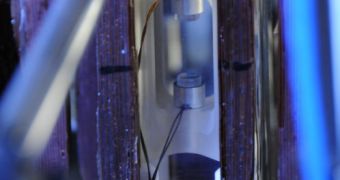Experts at the Joint Institute for Laboratory Astrophysics, now known simply as JILA, and the US National Institute of Standards and Technology (NIST), announce the creation of a new type of superradiant laser, which is many times more stable than similar devices.
According to the joint physics team, the novel design promises to be between 100 and 1,000 times more stable than the most advanced visible lasers available today. Potential applications include uses in atomic clocks and several related technologies.
These clocks are today used to coordinate the activities of space-based instruments and spacecraft, for global communications, and for conducting positioning and navigation calculations. The entire GPS satellite constellation relies on the precision of atomic clocks for the services it provides.
In a paper published in the April 5 issue of the top scientific journal Nature, the group explains that the laser uses 1 million rubidium atoms, which are made to conduct a “synchronized dance” between two mirrors. The end result is a dim beam of ultra-deep red laser light.
According to JILA/NIST physicist James Thompson, the engineering technique that makes this prototype possible is called phased arrays. A large group of identical antennas are used to create synchronized electromagnetic waves with a wide array of controllable, useful features.
“It's like what happens in the classical world but with quantum objects. If you line up lots of radio antennas that each emit an oscillating electric field, you can get all their electric fields to add up to make a really good directional antenna,” the investigator explains.
“In the same way, the individual atoms spontaneously form something like a phased array of antennas to give you a very directional laser beam,” he adds.
“This superradiant laser is really, really dim – about a million times weaker than a laser pointer. But it is much brighter than one would expect from the ordinary uncoordinated emissions from individual atoms,” Thompson goes on to say.
The new study was made possible by funds secured from the US National Science Foundation (NSF), NIST, the Army Research Office and the Defense Advanced Research Projects Agency (DARPA).

 14 DAY TRIAL //
14 DAY TRIAL // 